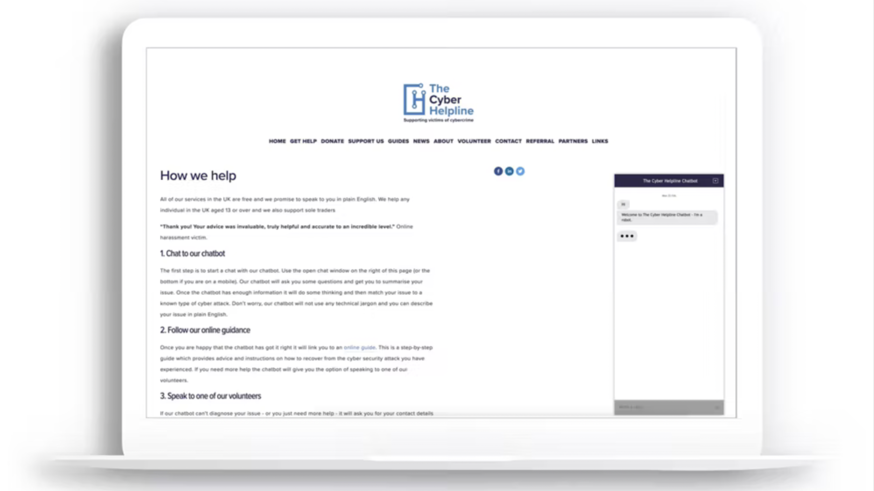Challenge
Cybercrime is a rising threat, both in the UK and globally. It’s a type of crime that doesn’t discriminate, affecting both businesses and individuals. Malware, fraud and hacking cost governments billions to clean up.
The Cyber Helpline is a not for profit which provides free support by cyber security experts to UK victims. We partnered with the charity to help them deliver this support via a chatbot, using technology to aid victims by containing threats where possible and offering comprehensive support in the post crime recovery phase.
Solution
The Cyber Helpline has an urgent need to support victims of cybercrime at any time of day or night. During the pandemic, many human support call centres had been compromised and so rates of cybercrime were rising. As a result, the charity wanted to design and build a chatbot which could navigate the complex world of cybercrime.
Individual victims of cybercrime don’t use technical terminology when describing what happened to them and most help systems ask you a series of questions to diagnose the problem. To better provide access to help, our team had to allow the victim to write freely, using their own language. We used Natural Language Processing (NLP) and Machine Learning technology, which could interpret categories and diagnose an attack without requiring technical terms.
Our teams used knowledge graphs, which can connect intent, phrases, nouns and adjectives to associated concepts. This way, we could capture cyber security expert experience, and build the platform in a way which meant it could continue to be trained over time, as new instances of cybercrime evolve.
Impact
The Cyber Helpline’s new chatbot uses OpenDialog’s web chat module to interact with victims. It allows them to report their problem descriptively in their own language and provides them with detail on the most likely cause of their attack. The bot also advises on the next steps to protect themselves.
If the first diagnosis is not correct, the next most likely cause is suggested, and the chatbot continues to learn from this data. So far, it’s provided around 85% of users with a correct diagnosis. Only 1 in 10 cases now reach volunteers, which allows cybercrime experts to focus on more complex, high risk cases that demand more help and attention.
Freeing up this capacity through automation has allowed a higher volume of cases to be supported, at minimal cost and with few resource requirements.
Our latest work
Transformation is for everyone. We love sharing our thoughts, approaches, learning and research all gained from the work we do.

Designing a carbon footprint reduction service for homeowners
How we created a service for councils to empower individuals to retrofit their homes and work towards Net Zero with Connected Places Catapult.
Read more
Implementing a global people analytics system for a leading bank
How we delivered a scalable HR analytics platform for one of the world’s biggest banks to meet its people's needs
Read more
Enhancing healthcare training data management
Building user-first data management systems with Health Education and Improvement Wales
Read more
